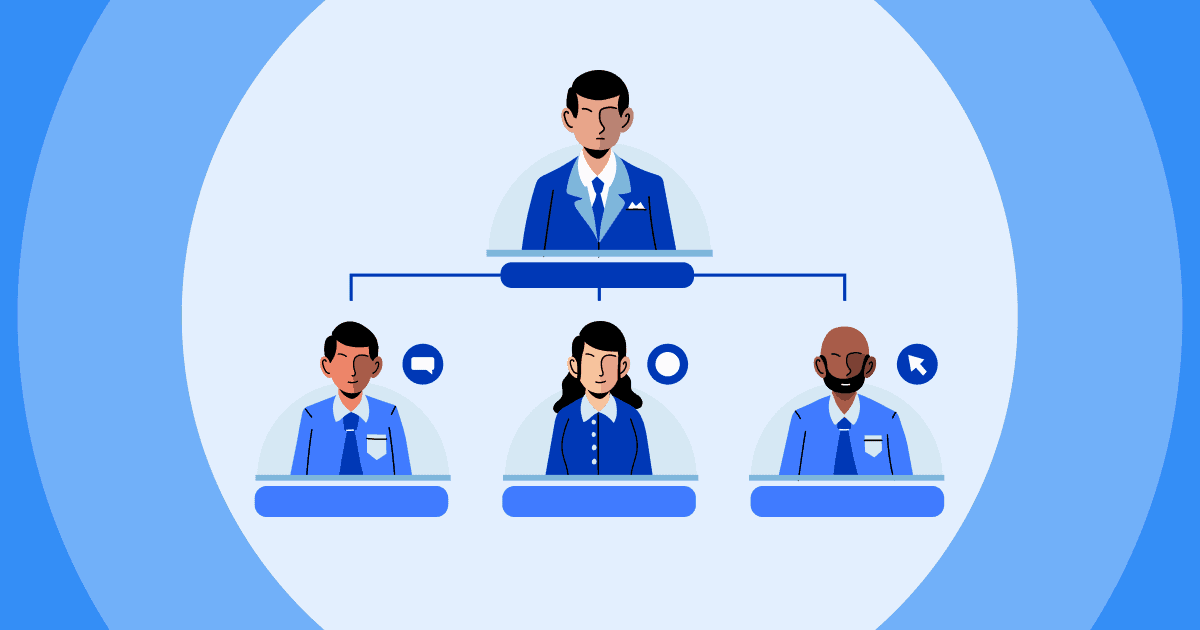어떤 회사는 모든 것을 하나로 합친 것처럼 보이는 반면 다른 회사는 혼란 속에서 바퀴를 돌리는 모습이 궁금하십니까? 그 비밀은 종종 조직 구조에 있습니다.
건축가가 건물의 청사진을 설계하는 것처럼, 회사의 리더십은 자사 사업을 위한 완벽한 프레임워크를 구축해야 합니다.
그러나 가만히 서 있는 건물과 달리 기업은 시간이 지남에 따라 적응해야 하는 살아 숨쉬는 유기체입니다.
오늘은 성과가 좋은 조직의 베일을 벗고, 그들을 움직이는 구조적 마법을 살펴보겠습니다.
우리는 함께 다양한 것을 탐험할 것입니다 조직 구조의 유형 어느 것이 당신에게 가장 적합한 지 확인하십시오.
회사 개요
| 가장 일반적으로 사용되는 조직 구조는 무엇입니까? | 계층 구조 |
| 가장 어려운 조직 구조 유형은 무엇입니까? | 매트릭스 구조 |
| 회사 환경이 안정적이라면 어떤 유형의 구조를 선택하겠습니까? | 기능적 구조 |
차례
AhaSlides를 활용한 더 많은 팁

모임 중에 더 많은 재미를 찾고 계십니까?
AhaSlides에서 재미있는 퀴즈로 팀원들을 모아보세요. AhaSlides 템플릿 라이브러리에서 무료 퀴즈에 참여하려면 가입하세요!
🚀 무료 퀴즈 받기☁️
조직 구조란 무엇입니까?

조직 구조는 조직의 목표를 달성하기 위해 직원들이 함께 일하도록 통제, 조정 및 동기를 부여하는 공식적인 업무 시스템 및 보고 관계를 의미합니다. 그만큼 중요 요소들 조직 구조를 정의하는 요소는 다음과 같습니다.
- 분업 – 업무 활동을 수행할 특정 직무나 업무로 분할하는 것. 여기에는 전문화와 부서화가 포함됩니다.
- 세분화 – 공통 기능(예: 마케팅 부서)이나 서비스를 제공하는 고객/타겟 그룹(예: 사업 개발 부서)을 기준으로 업무를 부서로 그룹화합니다.
- 명령 계통(Chain of Command) – 누가 누구에게 보고하는지 명시하는 권한 체계로, 조직의 위계 질서를 반영합니다. 이는 관리 계층과 위계를 보여줍니다.
- 통제 범위 – 관리자가 효과적으로 감독할 수 있는 직속 부하 직원의 수. 통제 범위가 넓을수록 관리 계층이 줄어듭니다.
- 중앙집권화 vs. 분권화 – 조직 내 의사 결정 권한이 어디에 있는지를 나타냅니다. 중앙집권적 구조는 권한이 상부에 집중되는 반면, 분권적 구조는 권한이 분산됩니다.
- 형식화 – 규칙, 절차, 지시, 그리고 의사소통이 얼마나 체계적으로 기록되어 있는지를 나타냅니다. 공식화가 높을수록 규칙과 기준이 더 많아집니다.
조직 구조는 이러한 모든 요소들이 어떻게 조화를 이루어 성과를 최적화하고 회사 목표를 달성하는지를 결정합니다. 적절한 조직 구조 유형은 규모, 전략, 산업 등과 같은 요인에 따라 달라집니다. 리더십 스타일.
조직 구조의 유형
조직 구조의 유형은 무엇입니까?
기업 세계에는 일반적으로 7가지 유형의 조직 구조가 있습니다. 이러한 다양한 조직 구조 중 어떤 구조는 상위 계층에 권력을 집중시키는 반면, 다른 구조는 계층 전체에 권력을 분산시킵니다. 유연성을 우선시하는 구조도 있고, 통제력을 최적화하는 구조도 있습니다. 기업에서 어떤 유형의 조직 구조가 있는지 살펴보겠습니다.
# 1. 팀 기반 조직 구조
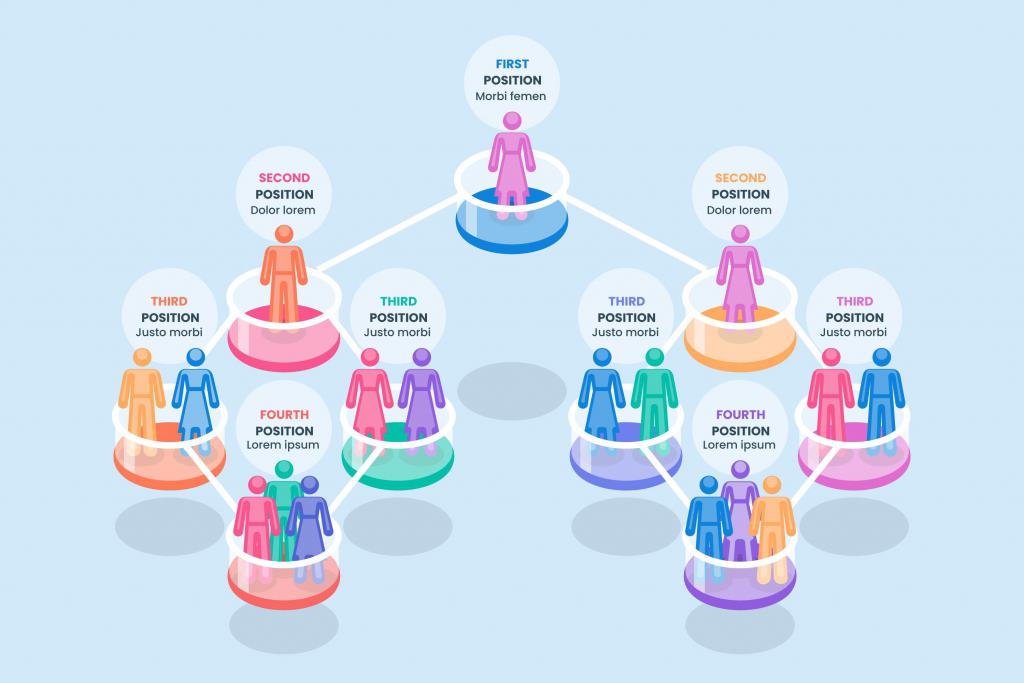
A 팀 기반 조직 구조 개인의 직무 역할이나 전통적인 부서가 아닌 주로 팀을 중심으로 작업이 구성되는 방식입니다.
팀은 특정 프로젝트나 목표를 수행하기 위해 다양한 기능 영역이나 부서의 직원을 모아 구성됩니다. 이들은 개별 목표보다는 공유된 목표와 결과에 중점을 둡니다. 성공이나 실패는 공동의 노력입니다. 이것이 무너진다 사일로.
팀은 자율적으로 관리됩니다. 즉, 높은 수준의 자율성을 가지고 관리자의 감독 없이 자체적인 업무 프로세스를 관리할 수 있는 권한을 부여받습니다. 팀은 상급자의 승인 없이도 일정, 업무 할당, 예산 책정, 프로세스 및 리소스와 같은 책임을 맡습니다.
수직적 계층 구조가 줄어들고 팀 간의 수평적 조정과 의사소통이 더 많아졌습니다. 팀 기반 조직 구조에는 구성원들이 팀워크 기술을 향상시킬 수 있도록 상호 작용하고 협업할 수 있는 수많은 기회가 있습니다.
팀 구성원은 프로젝트와 우선순위가 변경됨에 따라 변경될 수 있습니다. 직원은 동시에 여러 팀에 속할 수 있습니다.
#2. 네트워크 구조
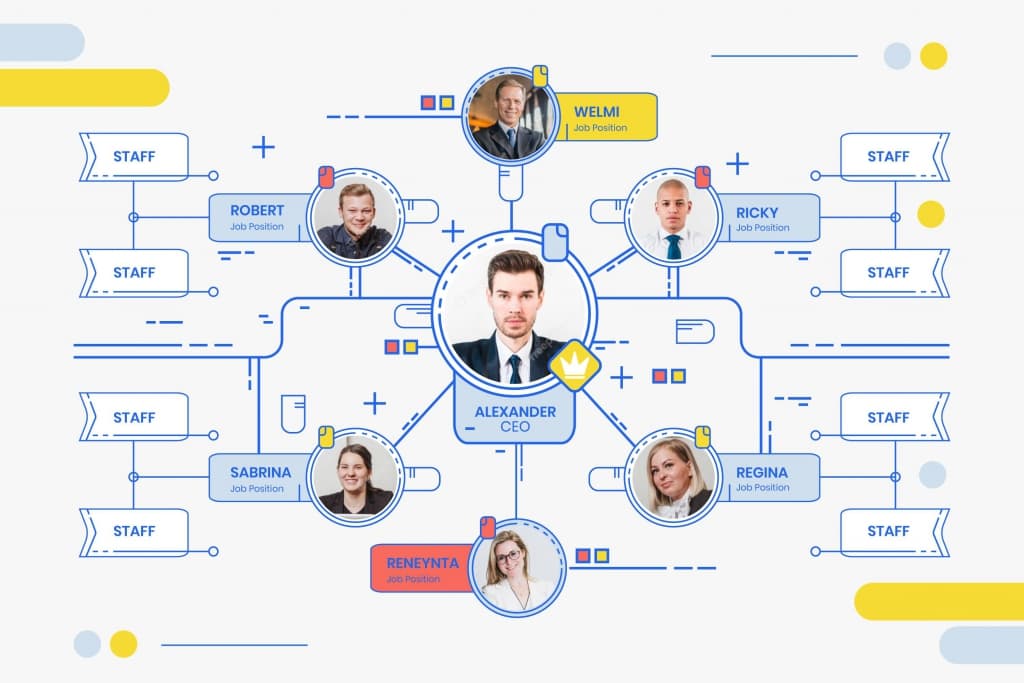
A 네트워크 구조 조직 설계에서는 고정된 부서나 직무 역할이 아닌 유연한 프로젝트 기반 팀을 기반으로 하는 모델을 말합니다.
팀은 필요에 따라 다양한 기술과 역할을 모아 프로젝트별로 구성됩니다. 프로젝트 종료 후 팀은 해산됩니다.
엄격한 관리자는 없으며 여러 팀 리더가 책임을 공유합니다. 권한은 역할과 전문 분야에 따라 분배됩니다.
정보는 하향식 계층 구조가 아닌 상호 연결된 팀을 통해 측면으로 흐릅니다.
직무 역할은 고정된 직위가 아닌 기술/지식 기여도를 기반으로 역동적이고 정의됩니다.
조직 설계는 엄격한 역할에 얽매이지 않고 발전하는 전략과 프로젝트에 따라 유연하게 변경될 수 있습니다. 개인의 기여도는 개별 성과 지표가 아닌 공동 성공을 기준으로 평가됩니다.
#삼. 계층적 구조
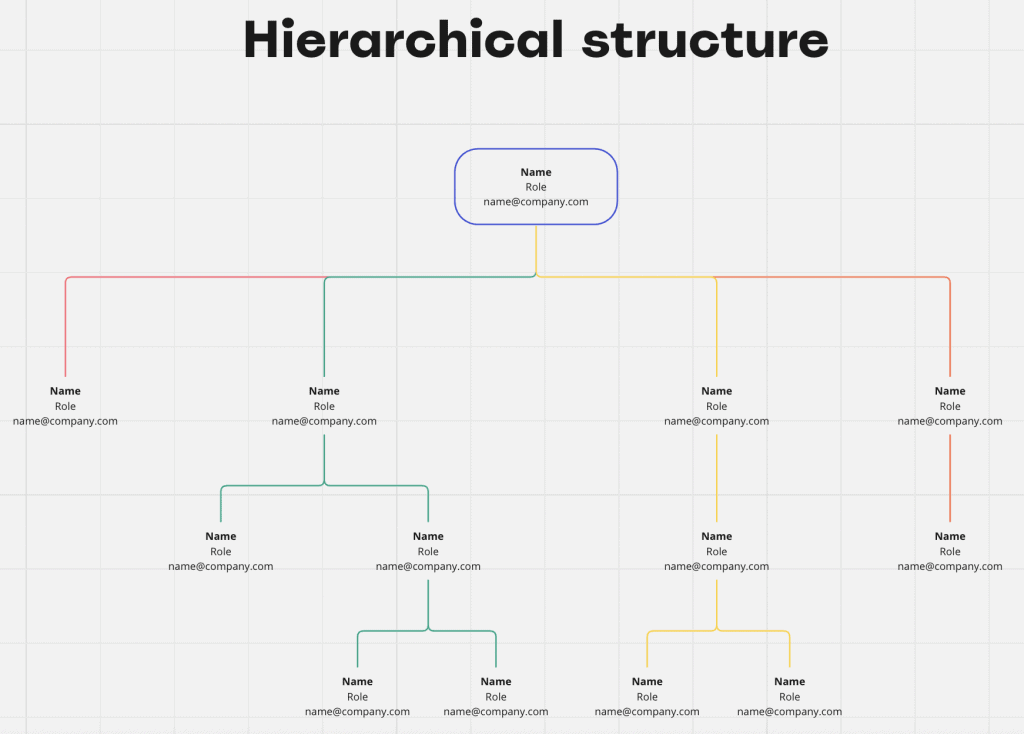
기본적인 조직 구조 중 하나로서, 계층적 조직 구조 권한이 최상위 경영진에서 다양한 수준의 중간 및 하위 경영진을 거쳐 일선 직원에게 전달되는 전통적인 하향식 구조입니다.
일반적으로 고위 경영진과 고위 경영진 사이에는 여러 수준의 관리자와 하위 관리자가 있습니다. 일선 직원.
전략적 결정은 자율성이 낮은 상위 수준에서 내려집니다.
업무는 전문적인 운영 업무와 부서로 세분화되어 유연성이 제한되어 있지만 승진 경로는 명확합니다.
커뮤니케이션은 주로 관리 계층을 통해 위에서 아래로 흐릅니다.
이 구조는 유연성이 필요하지 않은 예측 환경에서 안정적이고 기계적인 작업에 적합합니다.
#4. 매트릭스 조직 구조
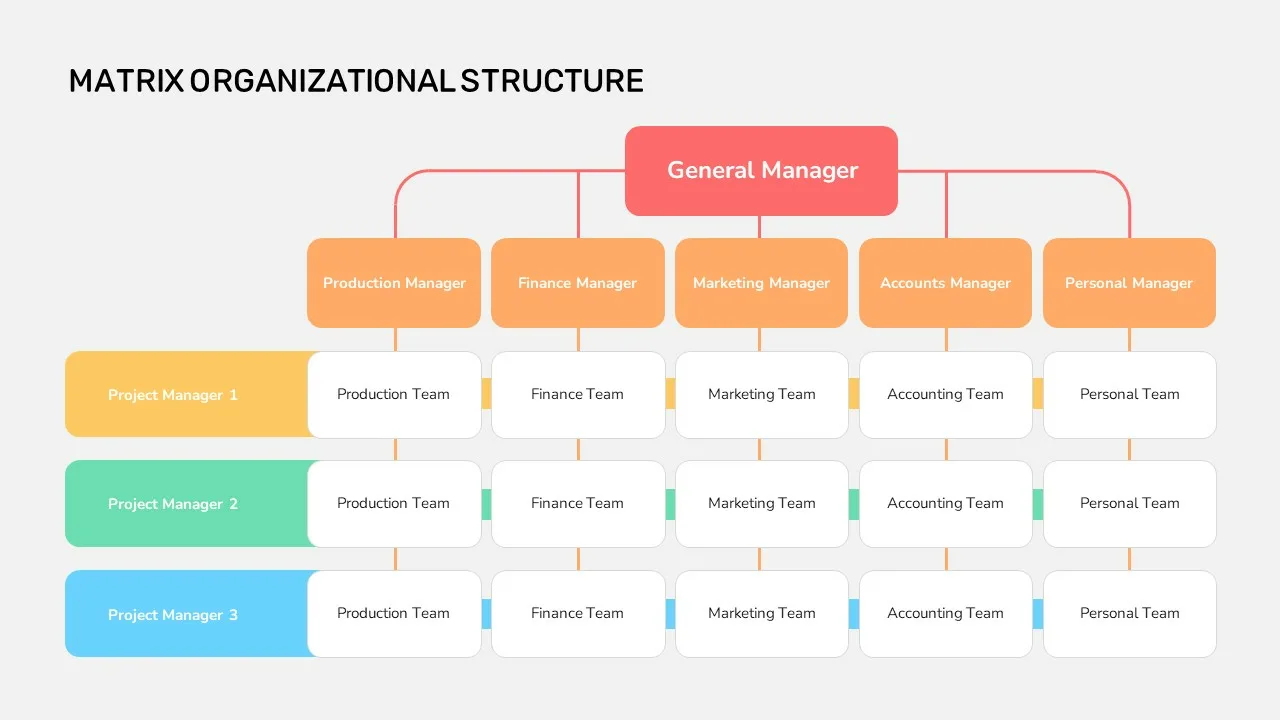
매트릭스 설정은 동시에 두 명의 보스를 갖는 것과 같습니다. 부서의 한 관리자에게만 보고하는 대신 사람들은 부서 책임자와 프로젝트 관리자 모두에게 보고합니다.
이 회사는 특정 프로젝트를 위해 서로 다른 팀의 사람들을 모았습니다. 따라서 엔지니어, 마케팅 담당자 및 영업 사원이 모두 같은 프로젝트 팀에서 잠시 동안 작업할 수 있습니다.
그들은 프로젝트 팀으로 일하지만, 각자는 여전히 정규 부서에 대한 책임을 져야 하므로, 마케터는 마케팅 부사장뿐 아니라 프로젝트 디렉터에게도 보고해야 합니다.
이로 인해 작업에 혼란이 생기고 부서 관리자와 프로젝트 관리자 사이의 갈등을 목격할 수 있으므로 몇 가지 문제가 발생할 수 있습니다.
이를 통해 기업은 프로젝트에 필요한 모든 전문가를 한자리에 모을 수 있습니다. 그리고 사람들은 전문적인 업무와 더 광범위한 프로젝트 모두에서 경험을 얻습니다.
#5. 수평적/평면적 조직구조
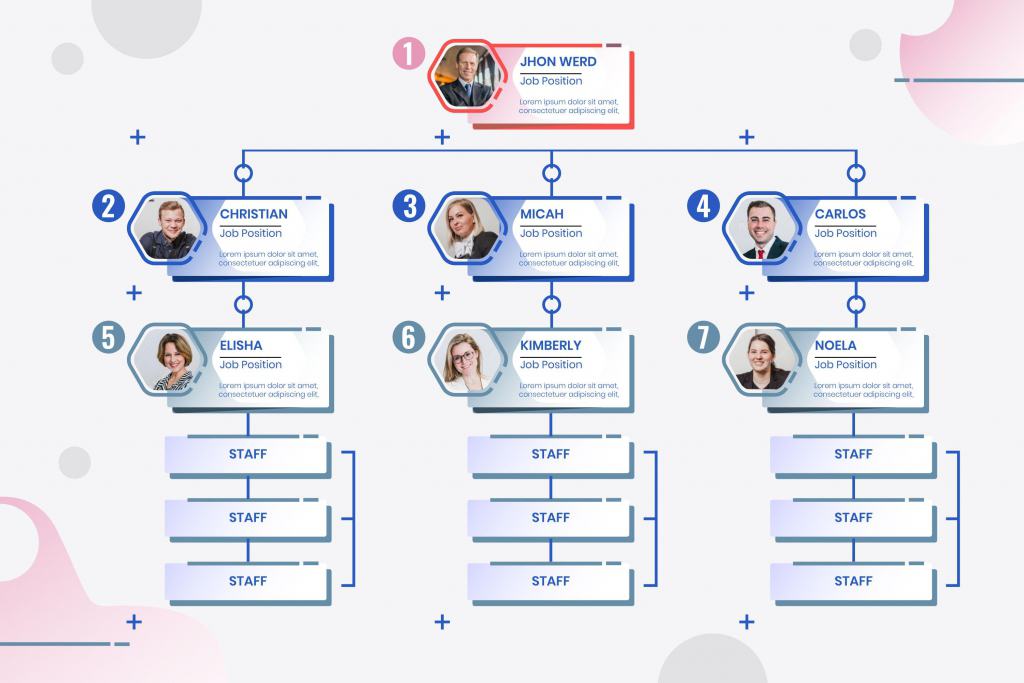
수평 또는 수평적 조직 구조 최고 경영진과 현장 직원 사이에 너무 많은 관리 직급이 없는 조직입니다. 크고 높은 위계질서 대신, 업무가 수평적으로 분산되어 있죠.
평면적 구조에서는 긴 명령 체계를 따라 위아래로 이동할 필요 없이 정보가 더 자유롭게 흐르는 경향이 있습니다. 서로 다른 팀 간의 의사소통도 더욱 유동적입니다.
의사결정이 상부에 덜 집중되어 있습니다. 리더십 팀은 개별 기여자에게 권한을 부여하고 업무에 대한 소유권을 부여하려고 노력합니다.
직원들은 매우 좁은 전문 역할보다는 더 많은 것을 스스로 관리하고 더 넓은 직무 범위를 가질 수 있습니다.
관리 계층이 줄어들어 간접 비용이 절감됩니다. 또한, 대규모 체인을 따라 여러 차례의 승인 절차를 거칠 필요가 없으므로 요청 처리 시간이 단축됩니다. 이는 신속한 의사 결정이 필요한 초기 단계의 스타트업과 소규모 기업에 적합합니다.
#6. 기능적 조직 구조
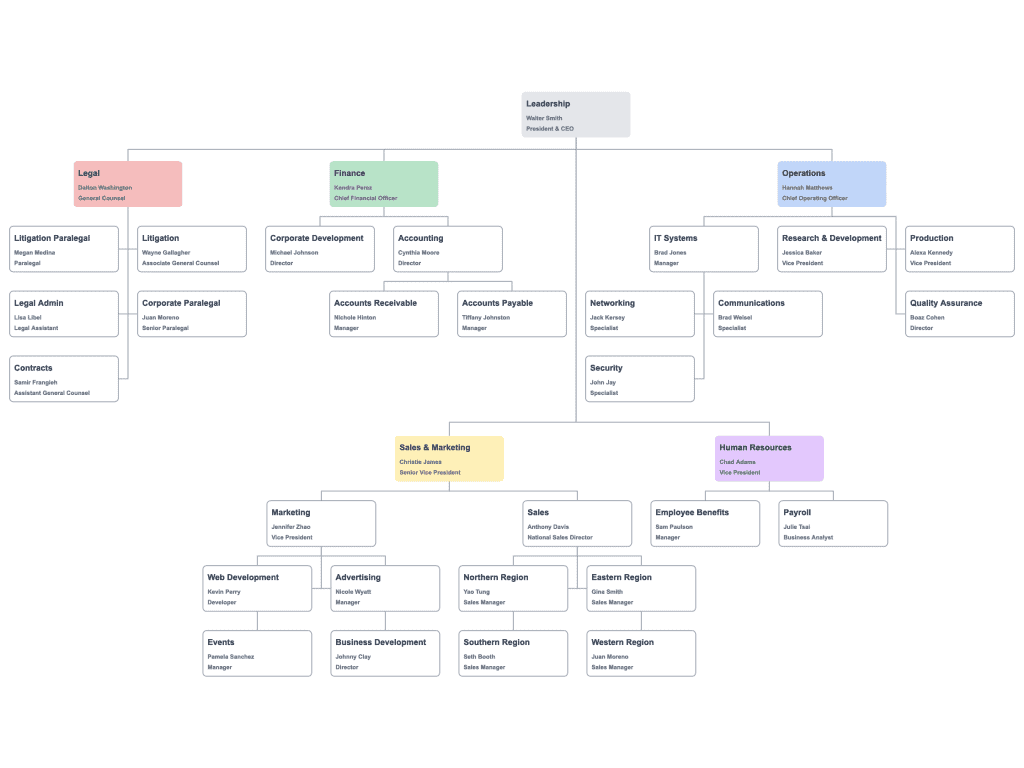
안에 기능적 조직 구조회사의 업무는 전문성이나 전문 분야를 기준으로 분류됩니다. 다시 말해, 업무 기능을 중심으로 구성됩니다.
일부 일반적인 기능 부서에는 다음이 포함됩니다.
- 마케팅 – 광고, 브랜딩, 캠페인 등을 담당합니다.
- 운영 – 생산, 공급망, 이행 등을 감독합니다.
- 재무 – 회계, 예산, 투자를 담당합니다.
- HR – 사람을 채용하고 관리합니다.
- IT – 기술 인프라와 시스템을 유지 관리합니다.
이러한 구성에서는 같은 분야(예: 마케팅)에서 일하는 사람들이 모두 같은 부서에 묶이게 됩니다. 그들의 상사는 해당 부서의 부사장이나 이사가 됩니다.
팀은 전문성을 최적화하는 데 내부적으로 집중하는 반면, 기능 간 조정에는 자체적인 노력이 필요합니다. 마케팅이 캠페인을 만드는 것처럼 운영은 브로셔 등을 인쇄합니다.
이는 직원들이 해당 분야의 다른 사람들과 함께 있을 때 심층적인 전문성을 개발하는 데 도움이 됩니다. 그리고 이는 직무 내에서 명확한 경력 경로를 제공합니다.
그러나 사람들이 사일로로 나뉘어 있기 때문에 협업이 더 어려울 수 있습니다. 그리고 고객은 전체적인 관점이 아닌 기능적인 관점을 통해 회사를 봅니다.
#7. 부문별 구조
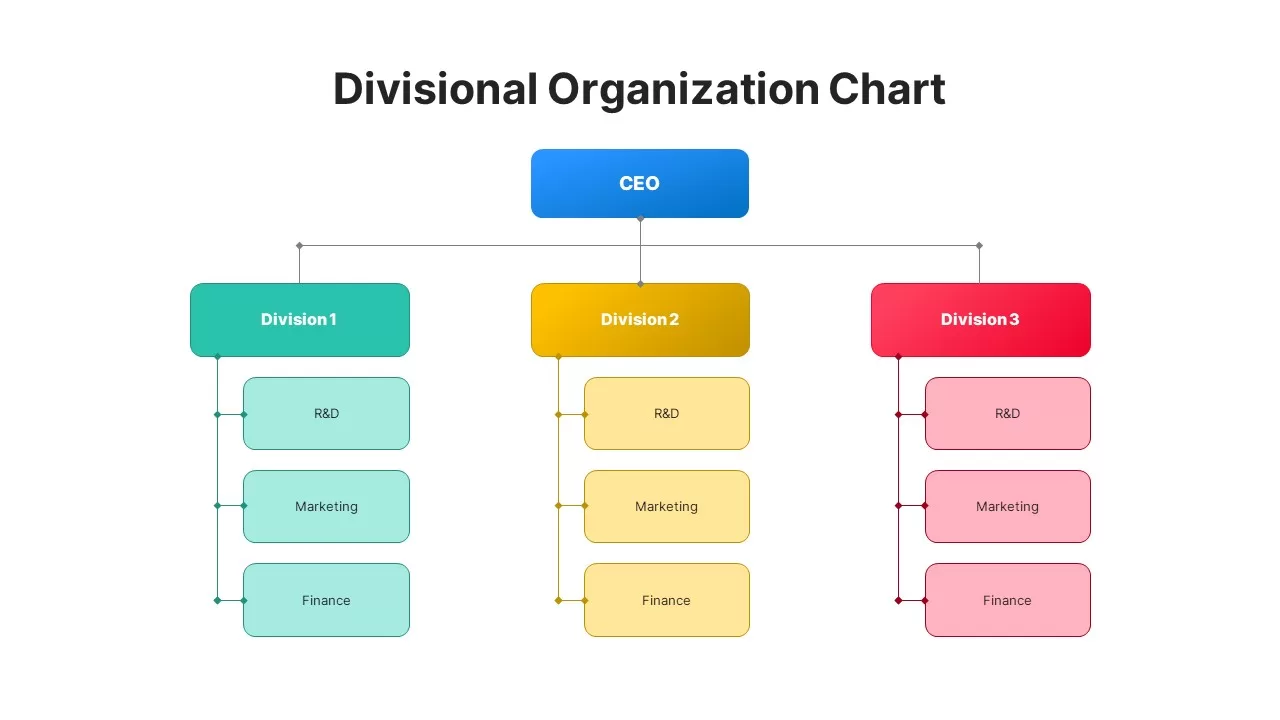
부서별 조직 구조 정의는 이해하기 매우 쉬운 것 같습니다. 부서 설정을 통해 회사는 기본적으로 회사가 만드는 다양한 유형의 제품이나 서비스를 제공하는 지역에 따라 별도의 섹션으로 나뉩니다. 이는 다양한 산업이나 장소에서 운영되는 다양한 회사에 적합합니다.
각 부서는 마치 하나의 작은 회사처럼 독립적으로 운영됩니다. 마케팅, 영업, 제조 등 각 사업 부문에 필요한 모든 것을 처리할 인력과 자원을 자체적으로 갖추고 있습니다.
그런 다음 각 부문의 리더는 주요 CEO에게 보고합니다. 하지만 그렇지 않은 경우에는 대부분의 부서가 자체적으로 결정을 내리며 자체적으로 수익을 창출하는 것을 목표로 합니다.
이 구조를 통해 각 섹션은 다루는 특정 시장 또는 고객에 실제로 집중하고 맞춤화할 수 있습니다. 회사 전체에 적용되는 획일적인 접근 방식이 아닙니다.
단점은 모든 것을 조정하는 데 작업이 필요하다는 것입니다. 각 부서는 시너지 효과 없이 각자의 일을 시작할 수도 있습니다. 그러나 올바르게 관리하면 여러 산업이나 영역을 다루는 비즈니스에 힘을 실어줄 수 있습니다.
주요 요점
대부분의 기업은 목표, 규모, 그리고 산업 역학에 따라 다양한 구조의 요소들을 통합합니다. 적절한 조합은 기업의 전략과 운영 환경에 따라 달라지지만, 이 7가지 유형의 조직 구조는 전 세계 여러 조직에서 사용되는 기본적인 구조적 틀을 포괄합니다.
자주 묻는 질문들 (FAQ)
4 가지 유형의 조직 구조는 무엇입니까?
조직 구조의 네 가지 주요 유형은 기능적 구조, 부서 구조, 매트릭스 구조 및 네트워크 구조입니다.
조직의 5가지 유형은 무엇입니까?
조직에는 기능적 구조, 프로젝트화된 구조, 네트워크 구조, 매트릭스 구조, 부서 구조의 5가지 유형이 있습니다.
